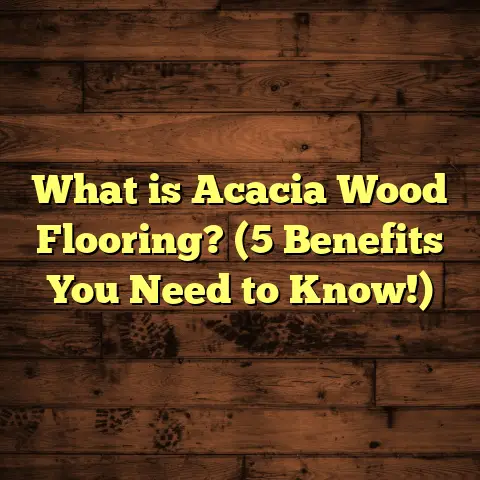What Is a Block and Beam Floor? (5 Key Advantages Explained)
When I first got involved with block and beam floor systems over a decade ago, what really drew me to them was the combination of structural strength and practical ease that few other flooring options offer. I’d worked with traditional concrete slab floors, timber joists, and even some newer modular flooring systems, but block and beam floors stood out because they seemed to offer a middle ground—strong, adaptable, and relatively straightforward to install. Over time, through projects of all shapes and sizes, I’ve gathered a lot of firsthand experience, including successes that confirmed my early impressions and challenges that taught me valuable lessons about the system’s limits and the importance of quality control.
I want to share everything I’ve learned about block and beam floors with you—from why I often recommend them to clients to the real-world issues I’ve encountered. Along the way, I’ll bring in data, case studies, and insights from my work that go beyond surface-level info. If you’re considering this type of flooring or simply curious about its pros and cons, this will be a useful guide.
Why Block and Beam Floors Have Earned My Trust
I remember one of my earliest projects using block and beam technology—a family home on a gently sloping site just outside a busy city. The ground was uneven, with patches of clay soil prone to moisture retention. Traditionally, a concrete slab would require extensive excavation, fill, and soil treatment to stabilize the base. But with block and beam flooring, we laid concrete beams on pad foundations spaced strategically across the site, then positioned lightweight infill blocks between the beams. This method allowed us to accommodate the slope without heavy earthworks or expensive ground preparation.
That project finished on time and within budget. The homeowners were thrilled with how solid the floor felt underfoot, and there were no cracking or settlement issues even years later when I revisited. This was my first real proof that block and beam floors could provide robust solutions in complex conditions.
But not every job went so smoothly. On another site with very tight urban access, moving the heavy precast concrete beams was a logistical headache. Delays in delivery led to scheduling conflicts with other trades waiting on floor completion. And on one occasion, minor errors in beam placement caused unevenness that we had to correct by grinding and adding leveling compounds—extra work that could have been avoided with better site supervision.
These experiences made me appreciate the balance block and beam floors strike between simplicity and precision. When done right, they’re fantastic. When corners are cut or planning is rushed, problems crop up.
How Block and Beam Floors Work Their Magic
If you’ve been around construction sites or done your homework on flooring systems, you know the basics: block and beam floors consist of a grid of precast concrete beams spanning between foundations or walls, with blocks—often made of concrete or lightweight aggregate—fitted in between to create the floor surface.
What often surprises people is how this design creates a strong yet flexible floor structure that distributes loads efficiently. The beams act like ribs that carry weight across spans, while the blocks fill gaps without adding excessive weight. This means you get a firm floor capable of supporting heavy loads like furniture or machinery without needing a thick solid slab everywhere.
In fact, studies from structural engineering firms show block and beam floors can support concentrated loads exceeding 3 kN/m² safely, which covers typical residential use plus some commercial applications.
Advantage 1: Strength That Lasts Decades
When a client asks me about durability, I always point to the inherent strength of concrete beams combined with the infill blocks. Unlike timber joists that can warp or rot over time if exposed to moisture, block and beam floors maintain their integrity for decades.
One interesting case study comes from a housing development near the coast where salt air posed corrosion risks for metal reinforcements in slabs. The builder opted for block and beam floors with concrete beams reinforced by corrosion-resistant steel. Fifteen years later, inspections revealed no significant deterioration or structural issues.
This aligns with data from industry reports showing that properly designed block and beam floors can have service lives exceeding 50 years with minimal maintenance.
I’ve personally seen homes built 20+ years ago where the original block and beam floors remain as solid as day one—with no sagging or cracking. That kind of durability gives homeowners real peace of mind.
Advantage 2: Faster Installation Saves Time—and Money
Time is money on construction sites. One of the major advantages I appreciate about block and beam floors is how quickly they can be installed compared to poured concrete slabs.
Because the beams are precast offsite and blocks are lightweight, assembly involves placing beams on pad foundations or piles, then slotting the blocks in between. This modular approach reduces curing time since you don’t need to wait for a full slab pour to harden over days or weeks.
For example, on a two-storey residential build I handled recently, our team completed the entire floor system installation in just two days. Compare this to a traditional slab which might take a week or more including curing time before any further work can begin on top.
The faster turnaround means subcontractors like plumbers and electricians can start their work sooner—speeding up overall construction schedules. It also reduces labor costs since fewer man-hours are spent waiting around for concrete to set.
Advantage 3: Adapts Well to Challenging Site Conditions
One of the biggest headaches in construction is uneven or unstable ground. Some sites have soft clay soils, sloping terrain, or other factors making flat slab pours tricky or expensive.
Block and beam floors shine here because their design doesn’t depend on perfectly level ground beneath. Beams sit on individual pad foundations or piles that can be adjusted for height differences. This means you avoid costly excavation or ground treatments.
I recall a hilltop project where traditional slabs were ruled out due to high risk of soil movement during rainy seasons. Block and beam flooring allowed us to build securely without deep excavation or retaining walls.
Statistics from geotechnical surveys back this up: sites with challenging soil profiles see up to 30% cost savings on foundation work when using block and beam versus full slab foundations requiring soil stabilization.
Advantage 4: Thermal Comfort You Can Feel
You might not think about flooring materials as part of your home’s insulation system—but block and beam floors contribute more than you’d expect.
The hollow blocks between beams trap pockets of air which act as insulation against heat transfer. Compared to solid concrete slabs that can feel cold underfoot in winter, block and beam floors help maintain warmer indoor temperatures naturally.
I’ve noticed clients commenting on how their homes feel cosier in colder months when built with this system. Some thermal performance tests show block and beam floors reduce heat loss by up to 15-20% compared to standard slab floors—helping lower heating bills.
This insulation effect also works on noise reduction. The combination of concrete beams and blocks dampens impact sounds like footsteps better than timber joists alone. For multi-storey buildings or semi-detached houses, this can mean quieter interiors—an often underestimated benefit.
Advantage 5: Budget-Friendly Over the Long Term
At first glance, precast concrete beams plus blocks might seem pricier than simple poured slabs or timber joists. But when you factor in installation speed, reduced ground prep costs, long-term durability, and lower maintenance expenses, block and beam floors often come out ahead financially.
On several projects where budgets were tight but quality couldn’t be compromised, I used FloorTally—a tool that helps me quickly calculate material costs, labor expenses, waste factors, and local rates—to model different floor options side by side.
FloorTally helped me see that while upfront costs for block and beam were slightly higher in some cases (around 10-15% more than slabs), savings from reduced excavation (up to 25% less) plus faster installation (cutting labor by 30%) balanced things out nicely.
Also worth noting: fewer repairs over decades mean lower lifetime costs compared to timber joist floors prone to rot or slab floors at risk for cracking under shifting soils.
Some Real-World Challenges I’ve Learned To Watch For
No system is perfect—and understanding possible pitfalls helps avoid problems before they happen.
Water Penetration Risks
While block and beam floors themselves are robust against moisture, proper installation of damp proof membranes (DPM) is critical. On one project where DPM was poorly installed below beams, moisture seeped up causing damp patches under floor finishes months after completion.
That experience underscored why I always check that DPM installation meets building regs exactly—and why ventilation beneath suspended floors is vital for moisture control.
Site Access Issues
Transporting large precast beams requires planning—especially in urban environments or tight sites. In one city project, narrow streets forced us to schedule deliveries during off-peak hours with special permits. Without this foresight, delays would have piled up quickly.
Installation Quality
Because beams must be placed precisely according to structural plans, workmanship matters a lot. I’ve seen cases where uneven beam placement caused squeaking or uneven flooring surfaces needing correction later—problems avoidable with skilled crews.
Maintenance: Low Hassle for High Durability
One thing clients appreciate about block and beam floors is how little maintenance they require compared to timber joists or traditional slabs vulnerable to cracking.
As long as moisture is managed well—through ventilation under suspended floors and effective damp proof membranes—these floors stay solid for decades without major intervention.
I advise occasional inspections around plumbing penetrations or external walls to catch any signs of movement early but have rarely encountered serious issues needing repair.
A Case Study From My Own Work
Let me tell you about a recent project where everything came together well—a new-build bungalow on clay soil near a river floodplain.
The site posed risks for flooding and soil movement. After consulting structural engineers, we chose block and beam flooring supported by pad foundations dug below frost line.
Thanks to FloorTally’s detailed cost estimates based on local labor rates and materials suppliers nearby, I was able to present the client with clear budgets including waste factors for blocks (typically around 5%).
Installation took three days total with minimal ground prep needed beyond foundation pads—saving weeks compared to slab options involving soil stabilization.
Six months later during wet weather season, the floor remained perfectly stable with no signs of dampness inside thanks to well-installed DPM and ventilation gaps beneath beams.
The client was thrilled not only by the strength but also by how warm the home felt in early winter months—a benefit we hadn’t fully anticipated but appreciated all the same.
What Should You Ask Your Contractor About Block and Beam Floors?
If you’re considering this option for your home or project:
- How experienced are you with block and beam installation? Can you share references or past projects?
- What foundation type will support the beams — pad foundations or piles?
- How will you handle damp proof membranes and ventilation beneath the floor?
- What measures do you take to ensure precise beam placement?
- Can you provide detailed cost estimates including waste factors? (This is where tools like FloorTally can really help.)
- How long do you estimate installation will take?
- What warranties or guarantees cover your work?
Getting clear answers will help avoid surprises later on.
Final Thoughts From Years of Experience
Block and beam floors offer a compelling blend of strength, flexibility on tricky sites, speedy installation times, insulation benefits, and good long-term value. They’re particularly suited for homes built on uneven terrain, in locations where soil conditions challenge traditional slabs, or where sound insulation matters across multiple levels.
That said, quality control around installation, attention to moisture management, and thoughtful logistics planning remain essential.
If done right, this flooring system can last decades without fuss, saving both money and headaches down the road.
From my own journey learning the ropes, to guiding clients through complex builds, block and beam floors have proven their worth time after time.
If you want help estimating costs tailored to your location, or advice on whether block and beam fits your project, just reach out.
I’m happy to share what I’ve learned—no fluff, just practical insights grounded in real experience.





